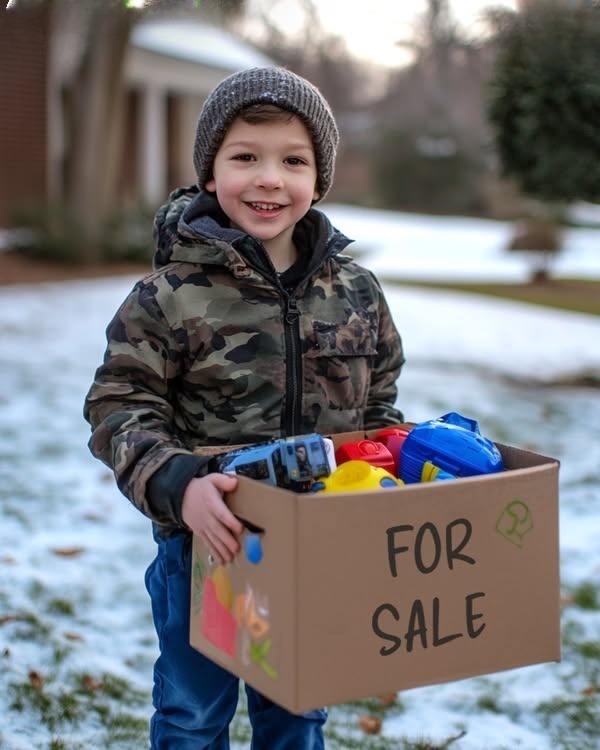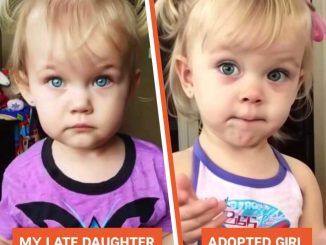
The morning air was crisp with the promise of a new day. George and I, bundled in our warmest coats, were on our usual walk, enjoying the quiet of our suburban street. The sun, a shy sliver peeking through the clouds, cast long shadows across the lawns. As we passed apartment building number 7, something caught my eye.
A small figure huddled beside a makeshift table, a handwritten sign propped against a stack of toys. Curiosity piqued, I approached the boy. He couldn’t have been more than eight years old, his face a mixture of determination and sadness.
“What are you doing?” I asked gently.
The boy, with eyes the color of a stormy sea, looked up at me. “Selling my toys,” he said, his voice small but resolute. “To help my dog.”
My heart sank. “Your dog?” I asked, confused.
He nodded, his lip trembling slightly. “My parents… they can’t afford to keep him anymore. They might have to take him to the shelter.”
The words hung heavy in the air. This child, barely out of toddlerhood, was facing a hardship that no child should ever have to bear. George, ever the pragmatist, gently inquired about the prices of the toys. They were ridiculously low, a testament to the boy’s desperation.
We couldn’t just walk away. We “bought” a few of his toys, though we had no intention of keeping them. Instead, we returned home with a renewed sense of purpose. We started knocking on doors, sharing the boy’s story with our neighbors. The response was immediate and overwhelming.
Mrs. Garibaldi, the elderly woman who always had a jar of cookies on her windowsill, donated a generous sum, her eyes brimming with tears. Mr. Thompson, the gruff gardener with a soft spot for animals, offered to mow the family’s lawn for the next month. Children, their faces alight with concern, emptied their piggy banks, their contributions ranging from a few coins to a dollar bill clutched tightly in their small hands.
News of the boy’s plight spread through the neighborhood like wildfire. Within hours, a small “fund” for the dog’s care had materialized. We dropped off the contributions that evening, a small bag overflowing with cash and good wishes.
The boy’s face, when he saw the money, was a picture of disbelief. His eyes widened, then welled up with tears. “Thank you,” he whispered, his voice choked with emotion. “Thank you so much.” His parents, initially hesitant, were overcome with gratitude.
As we walked away, a sense of warmth filled my heart. It was a reminder that even in the face of adversity, the human spirit could shine through. The simple act of kindness, of reaching out to a neighbor in need, had created a ripple effect of compassion and support.
That evening, as I tucked my own children into bed, I told them about the little boy and his dog. I explained that sometimes, even the smallest acts of kindness could make a big difference. “Remember,” I said, “we’re all connected. We’re all part of a community, and we need to look out for each other.”
The next morning, I woke up to the sound of birdsong and the gentle patter of rain. The memory of the boy’s grateful smile warmed my heart. It was a reminder that even in the darkest of times, there is always hope, and that the kindness of strangers can truly make a difference.
That day, I went about my business with a renewed sense of purpose, determined to be more mindful of the needs of those around me. The world, I realized, was full of small acts of heroism, waiting to be discovered. And in the quiet moments, I would remember the little boy and his dog, a testament to the enduring power of compassion and the unwavering kindness of the human spirit.
Beyoncé Is Snubbed At 2024 Country Music Awards And The Beyhive Is Buzzing
Country music is always changing but there will also always be a core base of country music singers that stand out among the rest. These are more than just the singers that sell the most albums, they have country music in their blood.
Now that Beyoncé has entered into the genre of country music, her fans have loyally followed along. She did well with her country music hit, Texas Hold ’em, but that didn’t help her at the Country Music Awards (CMA).

Despite the fact that she had one of the biggest country music songs of the year, she didn’t receive a single nomination. This caused many of her fans to be up in arms, claiming that she should have received recognition at the awards and looking forward to her being the first black woman to be nominated for Album of the Year.
Her album, Cowboy Carter, was inspired due to the treatment she received at the 2016 CMA. She performed the song Daddy Lessons with The Chicks, and people were critical.
Even though she didn’t receive any awards, her success in the country music genre is unmistakable. She was at the top of the Billboard Hot Country Songs for 10 weeks consecutively, making it the second longest song of the year to obtain that goal.

In addition, she was the first black woman to be at the top of the charts in country music as a solo artist. Despite all of that, she didn’t receive nominations for any categories at the CMA.
Many of her friends, as well as media outlets, felt that she was being snubbed for her performance in 2016. Many have also said that just because she has a country music album does not mean that she is country.
Beyoncé said: “[The album was] born out of an experience that I had years ago where I did not feel welcomed… and it was very clear that I wasn’t”
There were many other factors that caused a stir among her fans as well as others who felt that she was snubbed on purpose at the awards. It’s all water under the bridge now, but it will be interesting to see what happens in 2025.



Leave a Reply